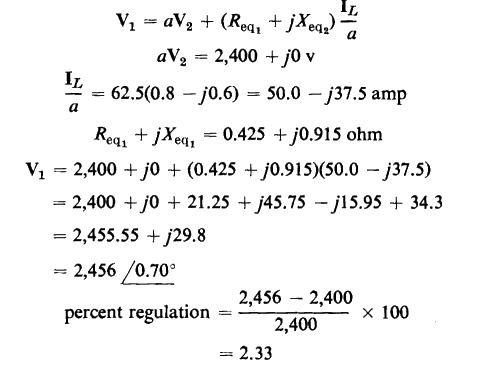| Capacitors, Magnetic Circuits, and Transformers is a free introductory textbook on the physics of capacitors, coils, and transformers. See the editorial for more information.... |

|

Home  The Transformer The Transformer  Voltage Regulation Voltage Regulation |
|||||||||






|
|||||||||
Voltage Regulation
An important measure of the performance of a transformer is its voltage regulation. The voltage regulation of a transformer is the change in the secondary voltage from its rated value at full load to that at no load in terms of rated secondary voltage when the primary voltage is held constant. Voltage regulation is usually expressed in percent, and is given by the relationship
where V2 is the rated secondary voltage at full load and Eoc2 is the no-load secondary voltage with the same value of primary voltage for both full load and no load. It is important to note that only the magnitudes rather than the phasor quantities of the voltages are involved in Eq. 6-60. The regulation of the transformer in Example 6-2 for full-load current at 0.80 power factor lagging is, according to Eq. 6-60
It is not necessary to carry out the calculations for transformers in as much detail as was done in Example 6-2. The approximate equivalent circuit is an adequate basis for calculations of regulation and affords a great deal of simplification. If the numerator and denominator in Eq. 6-60 are both multiplied by the ratio a, the result is
But aEoc2 = V1, the primary applied voltage, and we can now apply the phasor diagram of Fig. 6-15 for determining the regulation.
Certain types of loads operate most efficiently, and with long life, at their rated value of voltage and frequency. When operating appreciably above rated value, the load's life may become shortened, as in the case of incandescent lamps; on the other hand, operation at subnormal voltages leads to reduced efficiency, and, in the case of motors, may cause overheating at rated load. Such loads should be supplied by transformers that have small values of regulation. There are other types of loads that operate at nearly constant current, such as series lighting systems and electric welding arcs. Each such constant-current load is usually supplied from its own individual transformer - one that has a high value of regulation.
|
|||||||||
Home  The Transformer The Transformer  Voltage Regulation Voltage Regulation |
|||||||||
Last Update: 2011-02-16





